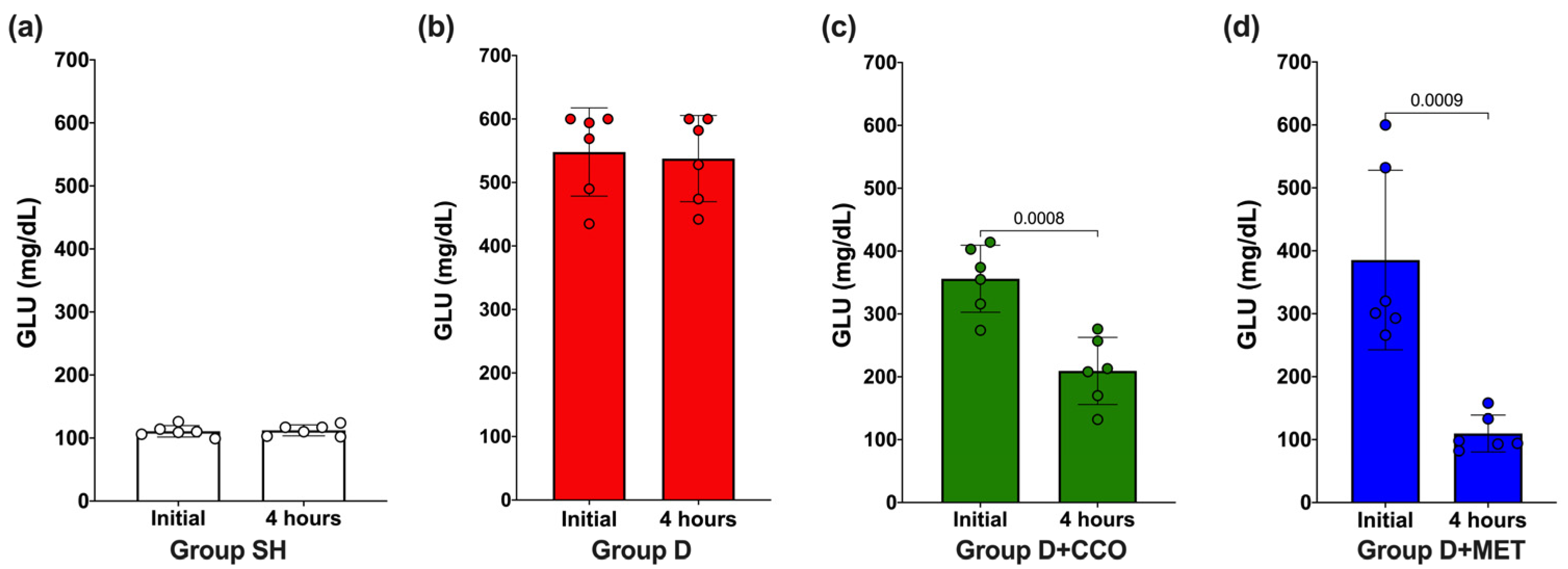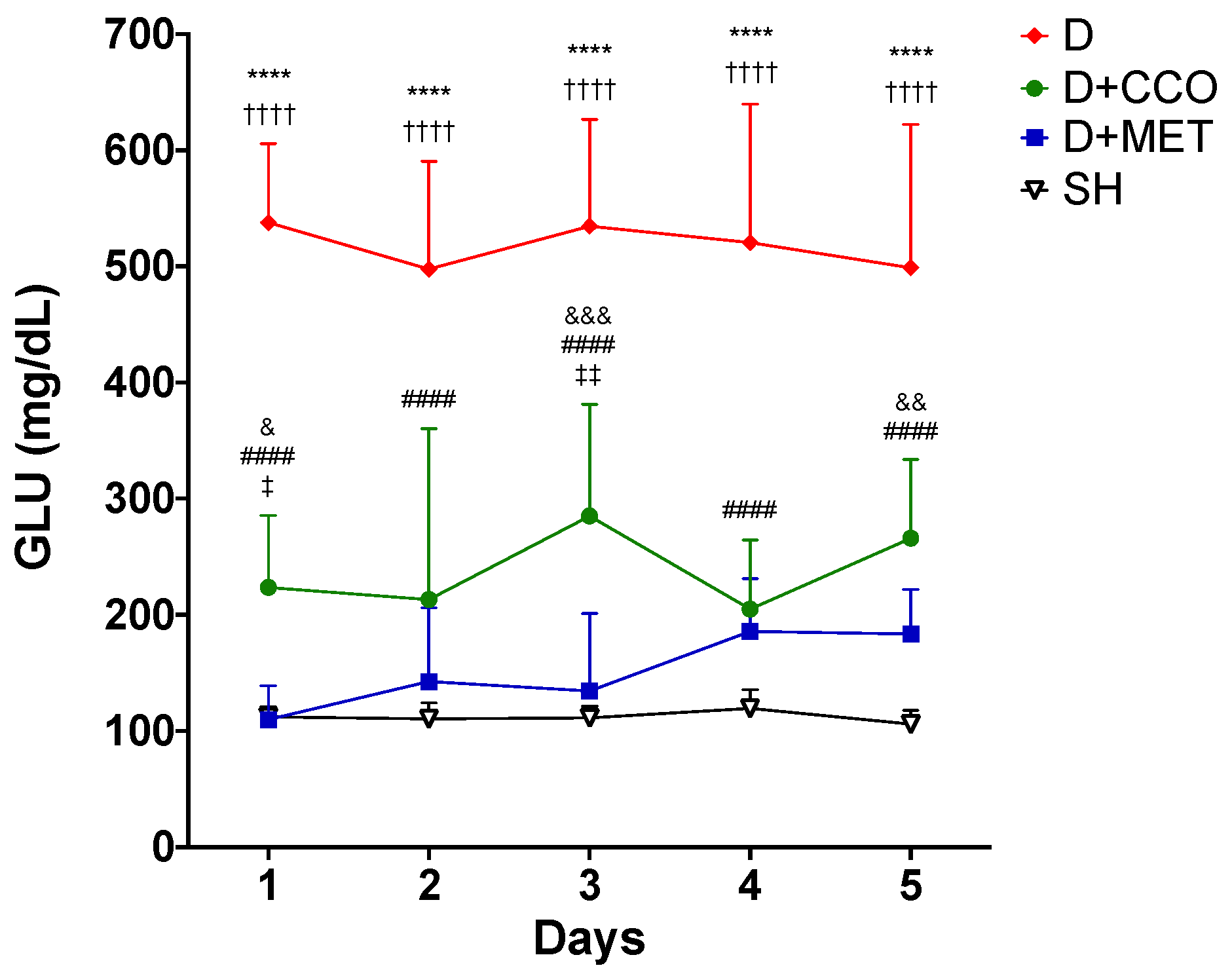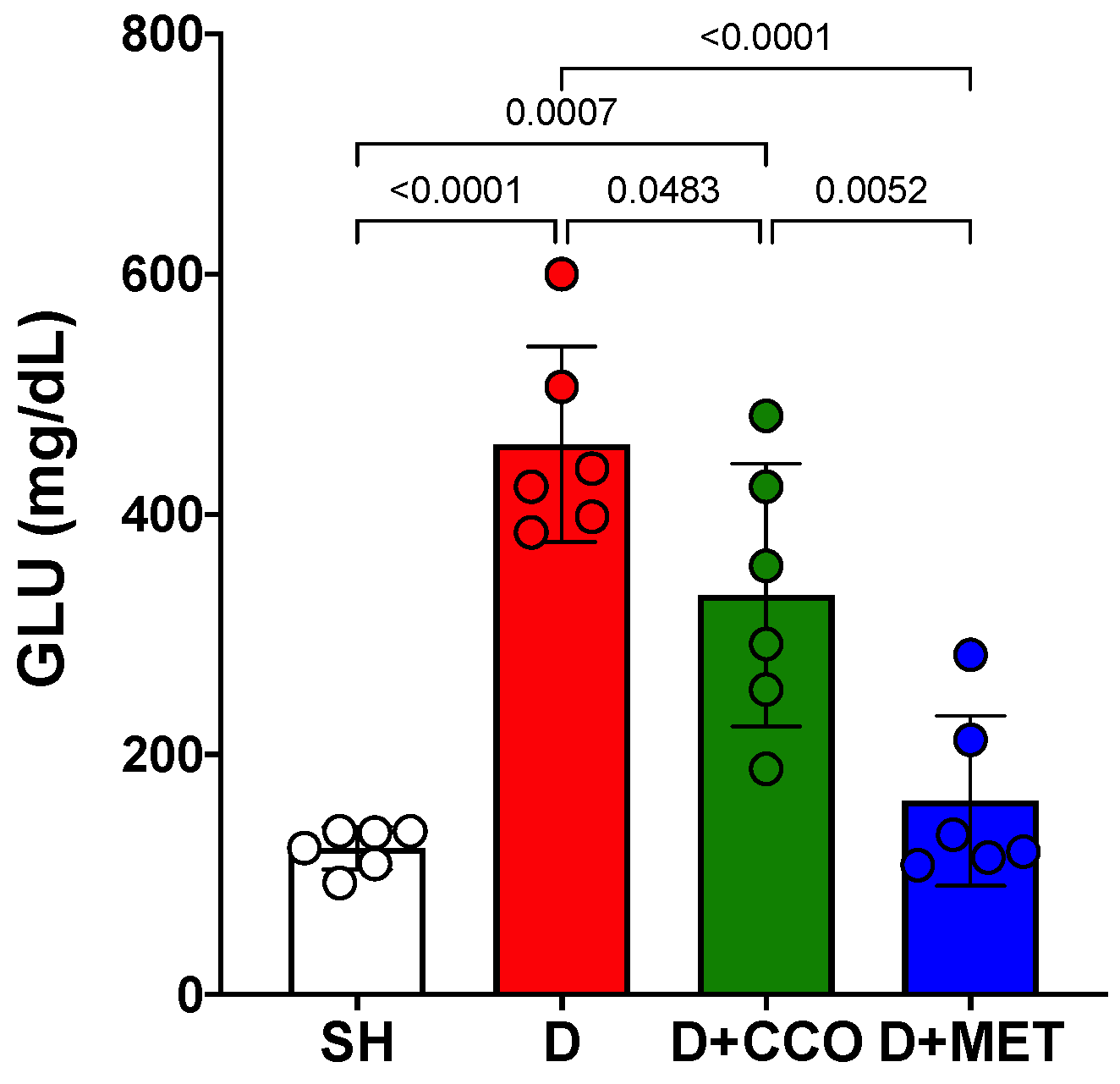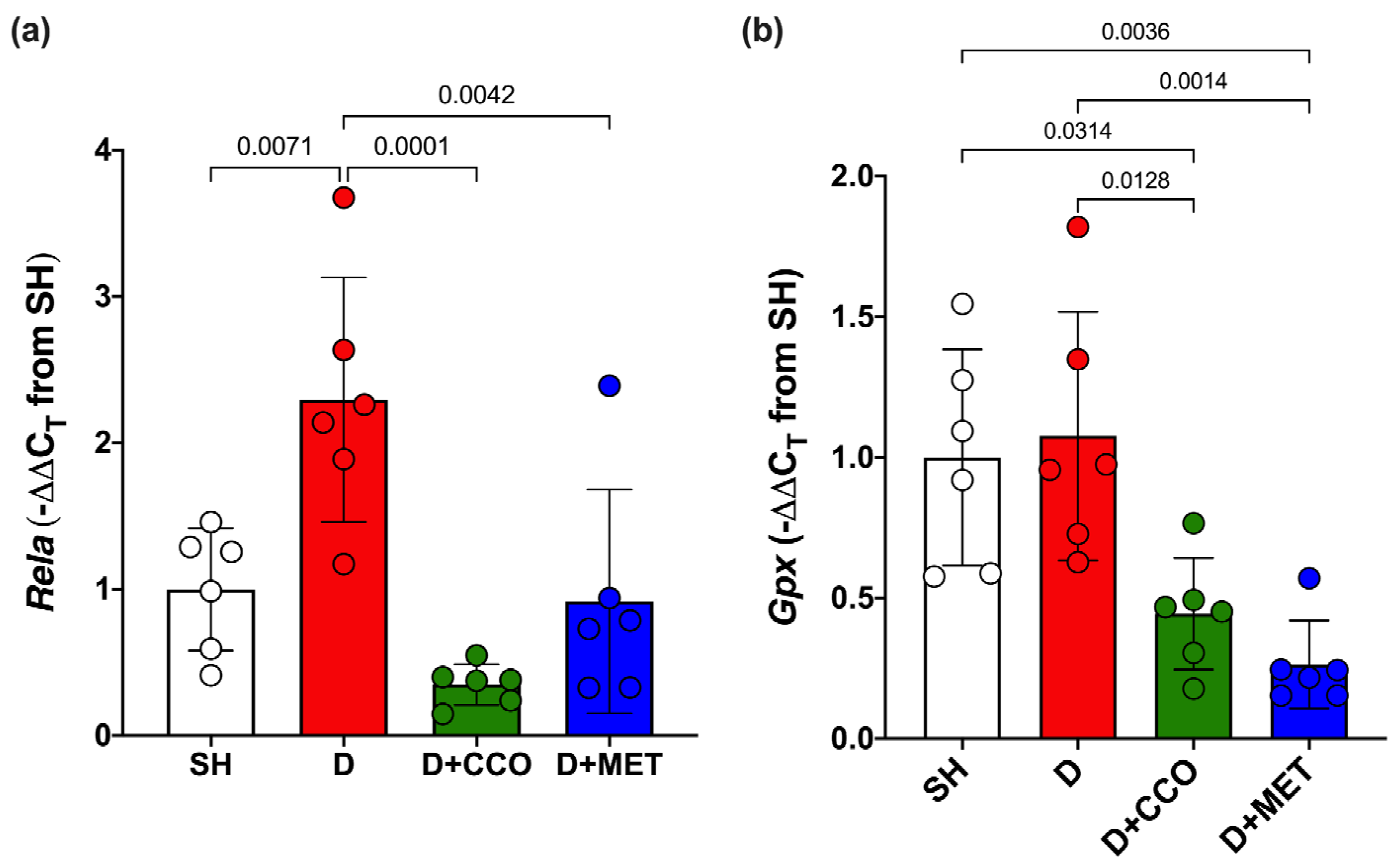Antidiabetic and Anti-Inflammatory Effect of Cinnamomum cassia Oil in Alloxan-Induced Diabetic Rats
Abstract
:1. Introduction
2. Results
2.1. GLU Levels after 4 h of CCO Administration
2.2. CCO Decreases GLU Levels throughout the Treatment
2.3. CCO on Liver and Kidney Function and Lipid Metabolism
2.4. Oxidative Stress Markers
2.5. Expression of Genes Associated with Inflammation and Oxidative Stress
3. Discussion
4. Materials and Methods
4.1. Chemicals, Reagents, and Sample Size
4.2. Diabetes Induction
4.3. Experimental Groups
4.4. GLU Measurement
4.5. Determination of Biochemical Markers
4.6. Determination of Oxidative Stress Markers
4.7. RNA Extraction and qRT-PCR
4.8. Statistical Analysis
5. Conclusions
Author Contributions
Funding
Institutional Review Board Statement
Informed Consent Statement
Data Availability Statement
Acknowledgments
Conflicts of Interest
References
- International Diabetes Federation. IDF Diabetes Atlas, 10th ed.; Boyko, E.J., Magliano, D.J., Karuranga, S., Piemonte, L., Pouya Saeedi, P.R., Sun, H., Eds.; Berkeley Communications: Reading, UK, 2021; ISBN 978-2-930229-98-0. [Google Scholar]
- López Stewart, G. Diabetes Mellitus: Clasificación, Fisiopatología y Diagnóstico. Medwave 2009, 9, e4315. [Google Scholar] [CrossRef]
- Leong, A.; Porneala, B.; Dupuis, J.; Florez, J.C.; Meigs, J.B. Type 2 Diabetes Genetic Predisposition, Obesity, and All-Cause Mortality Risk in the U.S.: A Multiethnic Analysis. Diabetes Care 2016, 39, 539–546. [Google Scholar] [CrossRef] [PubMed]
- Mendoza Romo, M.Á.; Padrón Salas, A.; Cossío Torres, P.E.; Soria Orozco, M. Prevalencia Mundial de La Diabetes Mellitus Tipo 2 y Su Relación Con El Índice de Desarrollo Humano. Rev. Panam. Salud Pública 2018, 41, e103. [Google Scholar] [CrossRef] [PubMed]
- Williams, R.; Karuranga, S.; Malanda, B.; Saeedi, P.; Basit, A.; Besançon, S.; Bommer, C.; Esteghamati, A.; Ogurtsova, K.; Zhang, P.; et al. Global and Regional Estimates and Projections of Diabetes-Related Health Expenditure: Results from the International Diabetes Federation Diabetes Atlas, 9th Edition. Diabetes Res. Clin. Pr. 2020, 162, 108072. [Google Scholar] [CrossRef]
- Darenskaya, M.A.; Kolesnikova, L.I.; Kolesnikov, S.I. Oxidative Stress: Pathogenetic Role in Diabetes Mellitus and Its Complications and Therapeutic Approaches to Correction. Bull. Exp. Biol. Med. 2021, 171, 179–189. [Google Scholar] [CrossRef]
- Newsholme, P.; Cruzat, V.F.; Keane, K.N.; Carlessi, R.; de Bittencourt, P.I.H. Molecular Mechanisms of ROS Production and Oxidative Stress in Diabetes. Biochem. J. 2016, 473, 4527–4550. [Google Scholar] [CrossRef] [PubMed]
- Khalili, F.; Vaisi-Raygani, A.; Shakiba, E.; Kohsari, M.; Dehbani, M.; Naseri, R.; Asadi, S.; Rahimi, Z.; Rahimi, M.; Rahimi, Z. Oxidative Stress Parameters and Keap 1 Variants in T2DM: Association with T2DM, Diabetic Neuropathy, Diabetic Retinopathy, and Obesity. J. Clin. Lab. Anal. 2022, 36, e24163. [Google Scholar] [CrossRef]
- Singh, A.; Kukreti, R.; Saso, L.; Kukreti, S. Mechanistic Insight into Oxidative Stress-Triggered Signaling Pathways and Type 2 Diabetes. Molecules 2022, 27, 950. [Google Scholar] [CrossRef]
- Luc, K.; Schramm-Luc, A.; Guzik, T.J.; Mikolajczyk, T.P. Oxidative Stress and Inflammatory Markers in Prediabetes and Diabetes. J. Physiol. Pharmacol. 2019, 70, 809–824. [Google Scholar] [CrossRef]
- Newsholme, P.; Cruzat, V.; Arfuso, F.; Keane, K. Nutrient Regulation of Insulin Secretion and Action. J. Endocrinol. 2014, 221, R105–R120. [Google Scholar] [CrossRef]
- Sadi, G.; Güray, T. Gene Expressions of Mn-SOD and GPx-1 in Streptozotocin-Induced Diabetes: Effect of Antioxidants. Mol. Cell Biochem. 2009, 327, 127–134. [Google Scholar] [CrossRef] [PubMed]
- Lontchi-Yimagou, E.; Sobngwi, E.; Matsha, T.E.; Kengne, A.P. Diabetes Mellitus and Inflammation. Curr. Diabetes Rep. 2013, 13, 435–444. [Google Scholar] [CrossRef]
- Karam, B.S.; Chavez-Moreno, A.; Koh, W.; Akar, J.G.; Akar, F.G. Oxidative Stress and Inflammation as Central Mediators of Atrial Fibrillation in Obesity and Diabetes. Cardiovasc. Diabetol. 2017, 16, 120. [Google Scholar] [CrossRef] [PubMed]
- Guo, W.; Song, Y.; Sun, Y.; Du, H.; Cai, Y.; You, Q.; Fu, H.; Shao, L. Systemic Immune-Inflammation Index Is Associated with Diabetic Kidney Disease in Type 2 Diabetes Mellitus Patients: Evidence from NHANES 2011–2018. Front. Endocrinol. 2022, 13, 1071465. [Google Scholar] [CrossRef]
- Lingappan, K. NF-ΚB in Oxidative Stress. Curr. Opin. Toxicol. 2018, 7, 81–86. [Google Scholar] [CrossRef]
- Sun, Z.; Andersson, R. NF-KappaB Activation and Inhibition: A Review. Shock 2002, 18, 99–106. [Google Scholar] [CrossRef]
- Rosenstock, J.; Allison, D.; Birkenfeld, A.L.; Blicher, T.M.; Deenadayalan, S.; Jacobsen, J.B.; Serusclat, P.; Violante, R.; Watada, H.; Davies, M.; et al. Effect of Additional Oral Semaglutide vs Sitagliptin on Glycated Hemoglobin in Adults with Type 2 Diabetes Uncontrolled with Metformin Alone or with Sulfonylurea: The PIONEER 3 Randomized Clinical Trial. JAMA 2019, 321, 1466–1480. [Google Scholar] [CrossRef] [PubMed]
- American Diabetes Association Professional Practice Committee 9. Pharmacologic Approaches to Glycemic Treatment: Standards of Care in Diabetes-2024. Diabetes Care 2024, 47, S158–S178. [Google Scholar] [CrossRef]
- Kim, S.H.; Hyun, S.H.; Choung, S.Y. Antioxidative Effects of Cinnamomi Cassiae and Rhodiola Rosea Extracts in Liver of Diabetic Mice. Biofactors 2006, 26, 209–219. [Google Scholar] [CrossRef]
- Xu, L.; Li, Y.; Dai, Y.; Peng, J. Natural Products for the Treatment of Type 2 Diabetes Mellitus: Pharmacology and Mechanisms. Pharmacol. Res. 2018, 130, 451–465. [Google Scholar] [CrossRef]
- Ríos, J.L.; Francini, F.; Schinella, G.R. Natural Products for the Treatment of Type 2 Diabetes Mellitus. Planta Med. 2015, 81, 975–994. [Google Scholar] [CrossRef]
- Watanabe, S.; Okoshi, H.; Yamabe, S.; Shimada, M. Moringa oleifera Lam. in Diabetes Mellitus: A Systematic Review and Meta-Analysis. Molecules 2021, 26, 3513. [Google Scholar] [CrossRef]
- Patle, D.; Vyas, M.; Khatik, G.L. A Review on Natural Products and Herbs Used in the Management of Diabetes. Curr. Diabetes Rev. 2021, 17, 186–197. [Google Scholar] [CrossRef]
- Qin, B.; Nagasaki, M.; Ren, M.; Bajotto, G.; Oshida, Y.; Sato, Y. Cinnamon Extract (Traditional Herb) Potentiates In Vivo Insulin-Regulated Glucose Utilization via Enhancing Insulin Signaling in Rats. Diabetes Res. Clin. Pr. 2003, 62, 139–148. [Google Scholar] [CrossRef] [PubMed]
- Balijepalli, M.K.; Buru, A.S.; Sakirolla, R.; Pichika, M.R. Cinnamomum Genus: A Review on Its Biological Activities. Int. J. Pharm. Pharm. Sci. 2017, 9, 1–11. [Google Scholar] [CrossRef]
- Alam, A.; Ansari, M.J.; Alqarni, M.H.; Salkini, M.A.; Raish, M. Antioxidant, Antibacterial, and Anticancer Activity of Ultrasonic Nanoemulsion of Cinnamomum cassia L. Essential Oil. Plants 2023, 12, 834. [Google Scholar] [CrossRef] [PubMed]
- Minozzo, M.; de Souza, M.A.; Bernardi, J.L.; Puton, B.M.S.; Valduga, E.; Steffens, C.; Paroul, N.; Cansian, R.L. Antifungal Activity and Aroma Persistence of Free and Encapsulated Cinnamomum cassia Essential Oil in Maize. Int. J. Food Microbiol. 2023, 394, 110178. [Google Scholar] [CrossRef]
- Afrin, F.; Chouhan, G.; Islamuddin, M.; Want, M.Y.; Ozbak, H.A.; Hemeg, H.A. Cinnamomum cassia Exhibits Antileishmanial Activity against Leishmania Donovani Infection In Vitro and In Vivo. PLoS Negl. Trop. Dis. 2019, 13, e0007227. [Google Scholar] [CrossRef]
- Fatima, M.; Zaidi, N.-U.-S.S.; Amraiz, D.; Afzal, F. In Vitro Antiviral Activity of Cinnamomum cassia and Its Nanoparticles Against H7N3 Influenza A Virus. J. Microbiol. Biotechnol. 2016, 26, 151–159. [Google Scholar] [CrossRef]
- Stevens, N.; Allred, K. Antidiabetic Potential of Volatile Cinnamon Oil: A Review and Exploration of Mechanisms Using In Silico Molecular Docking Simulations. Molecules 2022, 27, 853. [Google Scholar] [CrossRef]
- Chang, C.-T.; Chang, W.-L.; Hsu, J.-C.; Shih, Y.; Chou, S.-T. Chemical Composition and Tyrosinase Inhibitory Activity of Cinnamomum cassia Essential Oil. Bot. Stud. 2013, 54, 10. [Google Scholar] [CrossRef]
- Verspohl, E.J.; Bauer, K.; Neddermann, E. Antidiabetic Effect of Cinnamomum cassia and Cinnamomum zeylanicum In Vivo and In Vitro. Phytotherapy Res. 2005, 19, 203–206. [Google Scholar] [CrossRef] [PubMed]
- Yan, Y.-M.; Fang, P.; Yang, M.-T.; Li, N.; Lu, Q.; Cheng, Y.-X. Anti-Diabetic Nephropathy Compounds from Cinnamomum cassia. J. Ethnopharmacol. 2015, 165, 141–147. [Google Scholar] [CrossRef] [PubMed]
- Subash Babu, P.; Prabuseenivasan, S.; Ignacimuthu, S. Cinnamaldehyde—A Potential Antidiabetic Agent. Phytomedicine 2007, 14, 15–22. [Google Scholar] [CrossRef] [PubMed]
- Mohamed, S.M.; Shalaby, M.A.; El-Shiekh, R.A.; Bakr, A.F.; Kamel, S.; Emam, S.R.; El-Banna, H.A. Maca Roots: A Potential Therapeutic in the Management of Metabolic Disorders through the Modulation of Metabolic Biochemical Markers in Rats Fed High-Fat High-Carbohydrate Diet. J. Ethnopharmacol. 2024, 321, 117533. [Google Scholar] [CrossRef]
- Drobiova, H.; Thomson, M.; Al-Qattan, K.; Peltonen-Shalaby, R.; Al-Amin, Z.; Ali, M. Garlic Increases Antioxidant Levels in Diabetic and Hypertensive Rats Determined by a Modified Peroxidase Method. Evid.-Based Complement. Altern. Med. 2011, 2011, 703049. [Google Scholar] [CrossRef]
- Thomson, M.; Al-Qattan, K.K.; Js, D.; Ali, M. Anti-Diabetic and Anti-Oxidant Potential of Aged Garlic Extract (AGE) in Streptozotocin-Induced Diabetic Rats. BMC Complement. Altern. Med. 2016, 16, 17. [Google Scholar] [CrossRef]
- Rahmani, G.; Farajdokht, F.; Mohaddes, G.; Babri, S.; Ebrahimi, V.; Ebrahimi, H. Garlic (Allium sativum) Improves Anxiety- and Depressive-Related Behaviors and Brain Oxidative Stress in Diabetic Rats. Arch. Physiol. Biochem. 2020, 126, 95–100. [Google Scholar] [CrossRef]
- Mirazi, N.; Hosseini, A. Attenuating Properties of Rubus fruticosus L. on Oxidative Damage and Inflammatory Response Following Streptozotocin-Induced Diabetes in the Male Wistar Rats. J. Diabetes Metab. Disord. 2020, 19, 1311–1316. [Google Scholar] [CrossRef]
- Chehri, A.; Yarani, R.; Yousefi, Z.; Shakouri, S.K.; Ostadrahimi, A.; Mobasseri, M.; Araj-Khodaei, M. Phytochemical and Pharmacological Anti-Diabetic Properties of Bilberries (Vaccinium myrtillus), Recommendations for Future Studies. Prim. Care Diabetes 2022, 16, 27–33. [Google Scholar] [CrossRef] [PubMed]
- Chatzigeorgiou, A.; Halapas, A.; Kalafatakis, K.; Kamper, E. The Use of Animal Models in the Study of Diabetes Mellitus. In Vivo 2009, 23, 245–258. [Google Scholar] [PubMed]
- Szkudelski, T. The Mechanism of Alloxan and Streptozotocin Action in B Cells of the Rat Pancreas. Physiol. Res. 2001, 50, 537–546. [Google Scholar]
- Trevino-Moreno, S.G.; Moreno-Peña, D.P.; Viveros-Valdez, E.; Verde-Star, M.J.; Rivas-Morales, C.; Cordero-Perez, P. Evaluation of Hypoglycemic and Antioxidant Effects of Brickellia eupatorioides, Citrus limettioides and Gochnatia hypoleuca. Pak. J. Pharm. Sci. 2023, 36, 1619–1625. [Google Scholar] [PubMed]
- Rodríguez-Magaña, M.P.; Cordero-Pérez, P.; Rivas-Morales, C.; Oranday-Cárdenas, M.A.; Moreno-Peña, D.P.; García-Hernández, D.G.; Leos-Rivas, C. Hypoglycemic Activity of Tilia americana, Borago officinalis, Chenopodium nuttalliae, and Piper sanctum on Wistar Rats. J. Diabetes Res. 2019, 2019, 7836820. [Google Scholar] [CrossRef] [PubMed]
- Ighodaro, O.M.; Adeosun, A.M.; Akinloye, O.A. Alloxan-Induced Diabetes, a Common Model for Evaluating the Glycemic-Control Potential of Therapeutic Compounds and Plants Extracts in Experimental Studies. Medicina 2017, 53, 365–374. [Google Scholar] [CrossRef]
- Jörns, A.; Munday, R.; Tiedge, M.; Lenzen, S. Comparative Toxicity of Alloxan, N-Alkylalloxans and Ninhydrin to Isolated Pancreatic Islets In Vitro. J. Endocrinol. 1997, 155, 283–293. [Google Scholar] [CrossRef]
- Shaw Dunn, J.; Mcletchie, N.G.B. Experimental Alloxan Diabetes in the Rat. Lancet 1943, 242, 384–387. [Google Scholar] [CrossRef]
- Chougale, A.D.; Panaskar, S.N.; Gurao, P.M.; Arvindek, A.U. Optimization of Alloxan Dose Is Essential to Induce Stable Diabetes for Prolonged Period. Asian J. Biochem. 2007, 2, 402–408. [Google Scholar] [CrossRef]
- He, X.; Gao, F.; Hou, J.; Li, T.; Tan, J.; Wang, C.; Liu, X.; Wang, M.; Liu, H.; Chen, Y.; et al. Metformin Inhibits MAPK Signaling and Rescues Pancreatic Aquaporin 7 Expression to Induce Insulin Secretion in Type 2 Diabetes Mellitus. J. Biol. Chem. 2021, 297, 101002. [Google Scholar] [CrossRef]
- Ahmed Mobasher, M.; Galal El-Tantawi, H.; Samy El-Said, K. Metformin Ameliorates Oxidative Stress Induced by Diabetes Mellitus and Hepatocellular Carcinoma in Rats. Rep. Biochem. Mol. Biol. 2020, 9, 115–128. [Google Scholar] [CrossRef]
- Tan, H.; Chen, J.; Li, Y.; Li, Y.; Zhong, Y.; Li, G.; Liu, L.; Li, Y. Glabridin, a Bioactive Component of Licorice, Ameliorates Diabetic Nephropathy by Regulating Ferroptosis and the VEGF/Akt/ERK Pathways. Mol. Med. 2022, 28, 58. [Google Scholar] [CrossRef] [PubMed]
- Vijayakumar, K.; Rengarajan, R.L.; Suganthi, N.; Prasanna, B.; Velayuthaprabhu, S.; Shenbagam, M.; Vijaya Anand, A. Acute Toxicity Studies and Protective Effects of Cinnamon cassia Bark Extract in Streptozotocin-Induced Diabetic Rats. Drug Chem. Toxicol. 2022, 45, 2086–2096. [Google Scholar] [CrossRef]
- Castañeda, B.C.; de la Mata, R.C.; Mejia, R.M.; Vasquez, L.I.; Alarcón, R.F.; Mendoza, E.B. Estudio Fitoquímico y Farmacológico de 4 Plantas Con Efecto Hipoglicemiante. Horiz. Médico 2008, 8, 6–34. [Google Scholar] [CrossRef]
- Rao, B.K.; Kesavulu, M.M.; Apparao, C. Antihyperglycemic Activity of Momordica Cymbalaria in Alloxan Diabetic Rats. J. Ethnopharmacol. 2001, 78, 67–71. [Google Scholar] [CrossRef]
- Jawla, S.; Kumar, Y.; Khan, M.S. Antimicrobial and Antihyperglycemic Activities of Acacia Modesta Leaves. Pharmacologyonline 2011, 2, 331–343. [Google Scholar]
- Kingsley, R.B.; Jesuraj SA, V.; Brindha, P.; Subramoniam, A.; Atif, M. Anti-Diabetes Activity of Acacia farnesiana (L.) Willd in Alloxan Diabetic Rats. Int. J. PharmTech Res. 2013, 5, 112–118. [Google Scholar]
- Shalaby, M.; Saifan, H. Some Pharmacological Effects of Cinnamon and Ginger Herbs in Obese Diabetic Rats. J. Intercult. Ethnopharmacol. 2014, 3, 144. [Google Scholar] [CrossRef] [PubMed]
- Kim, S.H.; Hyun, S.H.; Choung, S.Y. Anti-Diabetic Effect of Cinnamon Extract on Blood Glucose in Db/Db Mice. J. Ethnopharmacol. 2006, 104, 119–123. [Google Scholar] [CrossRef]
- Kumar, S.; Vasudeva, N.; Sharma, S. GC-MS Analysis and Screening of Antidiabetic, Antioxidant and Hypolipidemic Potential of Cinnamomum tamala Oil in Streptozotocin Induced Diabetes Mellitus in Rats. Cardiovasc. Diabetol. 2012, 11, 95. [Google Scholar] [CrossRef]
- Mohammed, K.A.A.; Ahmed, H.M.S.; Sharaf, H.A.; El-Nekeety, A.A.; Abdel-Aziem, S.H.; Mehaya, F.M.; Abdel-Wahhab, M.A. Encapsulation of Cinnamon Oil in Whey Protein Counteracts the Disturbances in Biochemical Parameters, Gene Expression, and Histological Picture of the Liver and Pancreas of Diabetic Rats. Environ. Sci. Pollut. Res. 2020, 27, 2829–2843. [Google Scholar] [CrossRef]
- Ren, H.; Shao, Y.; Wu, C.; Ma, X.; Lv, C.; Wang, Q. Metformin Alleviates Oxidative Stress and Enhances Autophagy in Diabetic Kidney Disease via AMPK/SIRT1-FoxO1 Pathway. Mol. Cell. Endocrinol. 2020, 500, 110628. [Google Scholar] [CrossRef] [PubMed]
- Sachan, R.; Kundu, A.; Dey, P.; Son, J.Y.; Kim, K.S.; Lee, D.E.; Kim, H.R.; Park, J.H.; Lee, S.H.; Kim, J.H.; et al. Dendropanax morbifera Protects against Renal Fibrosis in Streptozotocin-Induced Diabetic Rats. Antioxidants 2020, 9, 84. [Google Scholar] [CrossRef]
- Sajid, M.; Khan, M.R.; Ismail, H.; Latif, S.; Rahim, A.A.; Mehboob, R.; Shah, S.A. Antidiabetic and Antioxidant Potential of Alnus nitida Leaves in Alloxan Induced Diabetic Rats. J. Ethnopharmacol. 2020, 251, 112544. [Google Scholar] [CrossRef] [PubMed]
- Nagai, H.; Shimazawa, T.; Takizawa, T.; Koda, A.; Yagi, A.; Nishioka, I. Immunopharmacological Studies of the Aqueous Extract of Cinnamomum cassia (CCAq). II. Effect of CCAq on Experimental Glomerulonephritis. Jpn. J. Pharmacol. 1982, 32, 823–831. [Google Scholar] [CrossRef]
- Ganesan, D.; Albert, A.; Paul, E.; Ananthapadmanabhan, K.; Andiappan, R.; Sadasivam, S.G. Rutin Ameliorates Metabolic Acidosis and Fibrosis in Alloxan Induced Diabetic Nephropathy and Cardiomyopathy in Experimental Rats. Mol. Cell Biochem. 2020, 471, 41–50. [Google Scholar] [CrossRef] [PubMed]
- Qusti, S.; El Rabey, H.A.; Balashram, S.A. The Hypoglycemic and Antioxidant Activity of Cress Seed and Cinnamon on Streptozotocin Induced Diabetes in Male Rats. Evid.-Based Complement. Altern. Med. 2016, 2016, 5614564. [Google Scholar] [CrossRef] [PubMed]
- Vijayakumar, K.; Prasanna, B.; Rengarajan, R.L.; Rathinam, A.; Velayuthaprabhu, S.; Vijaya Anand, A. Anti-Diabetic and Hypolipidemic Effects of Cinnamon cassia Bark Extracts: An In Vitro, In Vivo, and In Silico Approach. Arch. Physiol. Biochem. 2023, 129, 338–348. [Google Scholar] [CrossRef]
- Figueroa, M.C.; Pérez, I.H.; Mejía, R. Caracterización de Un Modelo de Diabetes Tipo 2 En Ratas Wistar Hembra. Rev. MVZ Córdoba 2013, 18, 3699–3707. [Google Scholar] [CrossRef]
- Shatwan, I.A.; Ahmed, L.A.; Badkook, M.M. Effect of Barley Flour, Crude Cinnamon, and Their Combination on Glycemia, Dyslipidemia, and Adipose Tissue Hormones in Type 2 Diabetic Rats. J. Med. Food 2013, 16, 656–662. [Google Scholar] [CrossRef]
- Vozarova, B.; Stefan, N.; Lindsay, R.S.; Saremi, A.; Pratley, R.E.; Bogardus, C.; Tataranni, P.A. High Alanine Aminotransferase Is Associated with Decreased Hepatic Insulin Sensitivity and Predicts the Development of Type 2 Diabetes. Diabetes 2002, 51, 1889–1895. [Google Scholar] [CrossRef]
- Kottaisamy, C.P.D.; Raj, D.S.; Prasanth Kumar, V.; Sankaran, U. Experimental Animal Models for Diabetes and Its Related Complications—A Review. Lab. Anim. Res. 2021, 37, 23. [Google Scholar] [CrossRef]
- Arkali, G.; Aksakal, M.; Kaya, Ş.Ö. Protective Effects of Carvacrol against Diabetes-Induced Reproductive Damage in Male Rats: Modulation of Nrf2/HO-1 Signalling Pathway and Inhibition of Nf-KB-Mediated Testicular Apoptosis and Inflammation. Andrologia 2021, 53, e13899. [Google Scholar] [CrossRef] [PubMed]
- Niazmand, S.; Mirzaei, M.; Hosseinian, S.; Khazdair, M.R.; Gowhari Shabgah, A.; Baghcheghi, Y.; Hedayati-Moghadam, M. The Effect of Cinnamomum cassia Extract on Oxidative Stress in the Liver and Kidney of STZ-Induced Diabetic Rats. J. Complement. Integr. Med. 2022, 19, 311–321. [Google Scholar] [CrossRef] [PubMed]
- Uslu, G.A.; Gelen, V.; Uslu, H.; Özen, H. Effects of Cinnamomum cassia Extract on Oxidative Stress, Immunreactivity of INOS and Impaired Thoracic Aortic Reactivity Induced by Type II Diabetes in Rats. Braz. J. Pharm. Sci. 2018, 54, e17785. [Google Scholar] [CrossRef]
- Riós, F.; Quintero, A.; Piloni, J.; Cariño, R.; Reyes, A. Compuestos Bioactivos de Canela y Su Efecto En La Disminución Del Síndrome Metabólico: Revisión Sistemática. Arch. Latinoam. Nutr. 2023, 73, 74–85. [Google Scholar] [CrossRef]
- Zhang, M.; Chen, Y.; Yang, M.-J.; Fan, X.-R.; Xie, H.; Zhang, L.; Nie, Y.-S.; Yan, M. Celastrol Attenuates Renal Injury in Diabetic Rats via MAPK/NF-ΚB Pathway. Phytother. Res. 2019, 33, 1191–1198. [Google Scholar] [CrossRef]
- Wang, R.-R.; Chen, X.-Y.; Liao, H.-L.; Wan, L.; Li, J.-M.; Chen, L.-L.; Chen, X.-F.; Chen, G.-R. The Relationship between the Expression of NF-KB, TGFbeta1, FN and Hepatic Fibrosis in Diabetic Rats. Zhonghua Gan Zang Bing Za Zhi 2010, 18, 194–198. [Google Scholar] [CrossRef]
- Reddy, A.M.; Seo, J.H.; Ryu, S.Y.; Kim, Y.S.; Kim, Y.S.; Min, K.R.; Kim, Y. Cinnamaldehyde and 2-Methoxycinnamaldehyde as NF-ΚB Inhibitors from Cinnamomum cassia. Planta Med. 2004, 70, 823–827. [Google Scholar] [CrossRef] [PubMed]
- Bagheri, S.; Sarabi, M.M.; Khosravi, P.; Khorramabadi, R.M.; Veiskarami, S.; Ahmadvand, H.; Keshvari, M. Effects of Pistacia Atlantica on Oxidative Stress Markers and Antioxidant Enzymes Expression in Diabetic Rats. J. Am. Coll. Nutr. 2019, 38, 267–274. [Google Scholar] [CrossRef]
- Bastos, M.S.; Del Vesco, A.P.; Santana, T.P.; Santos, T.S.; De Oliveira Junior, G.M.; Fernandes, R.P.M.; Barbosa, L.T.; Gasparino, E. The Role of Cinnamon as a Modulator of the Expression of Genes Related to Antioxidant Activity and Lipid Metabolism of Laying Quails. PLoS ONE 2017, 12, e0189619. [Google Scholar] [CrossRef]
- Sharma, S.; Mishra, A. Effects of Bark of Cinnamomum Zeylanicum on Hyperglycemia Induced Oxidative Stress and DNA Damage in Experimental Diabetic Rats. Int. J. Pharma Bio Sci. 2017, 8, 461–470. [Google Scholar] [CrossRef]
- Attanayake, A.P.; Jayatilaka, K.A.P.W.; Mudduwa, L.K.B.; Pathirana, C. β-Cell Regenerative Potential of Selected Herbal Extracts in Alloxan Induced Diabetic Rats. Curr. Drug Discov. Technol. 2019, 16, 278–284. [Google Scholar] [CrossRef]
- Ruda-Kucerova, J.; Amchova, P.; Babinska, Z.; Dusek, L.; Micale, V.; Sulcova, A. Sex Differences in the Reinstatement of Methamphetamine Seeking after Forced Abstinence in Sprague-Dawley Rats. Front. Psychiatry 2015, 6, 91. [Google Scholar] [CrossRef] [PubMed]
- Fedulova, L.V.; Basov, A.A.; Vasilevskaya, E.R.; Dzhimak, S.S. Gender Difference Response of Male and Female Immunodeficiency Rats Treated with Tissue-Specific Biomolecules. Curr. Pharm. Biotechnol. 2019, 20, 245–253. [Google Scholar] [CrossRef] [PubMed]
- Yamamoto, T.; Ohkuwa, T.; Itoh, H.; Sato, Y.; Naoi, M. Effect of Gender Differences and Voluntary Exercise on Antioxidant Capacity in Rats. Comp. Biochem. Physiol. Part C Toxicol. Pharmacol. 2002, 132, 437–444. [Google Scholar] [CrossRef] [PubMed]
- Kruger, N.J. The Bradford Method for Protein Quantitation. Methods Mol. Biol. 1994, 32, 9–15. [Google Scholar] [CrossRef]
- de Souza, M.C.; Vieira, A.J.; Beserra, F.P.; Pellizzon, C.H.; Nóbrega, R.H.; Rozza, A.L. Gastroprotective Effect of Limonene in Rats: Influence on Oxidative Stress, Inflammation and Gene Expression. Phytomedicine 2019, 53, 37–42. [Google Scholar] [CrossRef]







Disclaimer/Publisher’s Note: The statements, opinions and data contained in all publications are solely those of the individual author(s) and contributor(s) and not of MDPI and/or the editor(s). MDPI and/or the editor(s) disclaim responsibility for any injury to people or property resulting from any ideas, methods, instructions or products referred to in the content. |
© 2024 by the authors. Licensee MDPI, Basel, Switzerland. This article is an open access article distributed under the terms and conditions of the Creative Commons Attribution (CC BY) license (https://creativecommons.org/licenses/by/4.0/).
Share and Cite
Cordero-Pérez, P.; Hernández-Cruz, F.E.; Garza-Guzmán, D.; Moreno-Peña, D.P.; Sánchez-Martínez, C.; Torres-González, L.; Muñoz-Espinosa, L.E.; Zapata-Chavira, H.; Cura-Esquivel, I.; Serrano-Sandoval, M.I.; et al. Antidiabetic and Anti-Inflammatory Effect of Cinnamomum cassia Oil in Alloxan-Induced Diabetic Rats. Pharmaceuticals 2024, 17, 1135. https://doi.org/10.3390/ph17091135
Cordero-Pérez P, Hernández-Cruz FE, Garza-Guzmán D, Moreno-Peña DP, Sánchez-Martínez C, Torres-González L, Muñoz-Espinosa LE, Zapata-Chavira H, Cura-Esquivel I, Serrano-Sandoval MI, et al. Antidiabetic and Anti-Inflammatory Effect of Cinnamomum cassia Oil in Alloxan-Induced Diabetic Rats. Pharmaceuticals. 2024; 17(9):1135. https://doi.org/10.3390/ph17091135
Chicago/Turabian StyleCordero-Pérez, Paula, Flor Edith Hernández-Cruz, Daniel Garza-Guzmán, Diana Patricia Moreno-Peña, Concepción Sánchez-Martínez, Liliana Torres-González, Linda E. Muñoz-Espinosa, Homero Zapata-Chavira, Idalia Cura-Esquivel, Marisol Idalí Serrano-Sandoval, and et al. 2024. "Antidiabetic and Anti-Inflammatory Effect of Cinnamomum cassia Oil in Alloxan-Induced Diabetic Rats" Pharmaceuticals 17, no. 9: 1135. https://doi.org/10.3390/ph17091135






